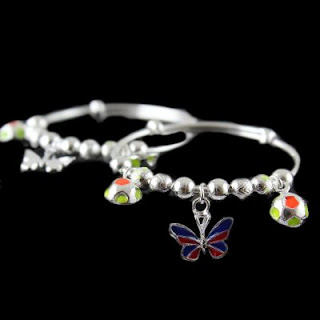Fancy Silver Anklets
An anklet, also called ankle chain, ankle bracelet or ankle string, is an ornament worn around the ankle. Barefoot anklets and toe rings historically have been worn for centuries by girls and women in India, where it is commonly known as pattilu, payal and sometimes as nupur. They have also been worn by Egyptian women since predynastic times. In the United States both casual and more formal anklets became fashionable from the 1930s to the late–20th century. While in Western popular culture both younger men and women may wear casual leather anklets, they are popular among barefoot women. Formal anklets (of silver, gold, or beads) are used by some women as fashion jewellery.[citation needed] Anklets are an important piece of jewellery in Indian marriages, worn along with saris.
Occasionally, anklets on both ankles are joined by a chain to limit the step. This practice was once prevalent in Southeast Asia, where the effect was to give a "feminine" short tripping step. Today, a few Western women follow this practice, but rarely in public. More rarely still, some people wear "permanent" (e.g., soldered) ankle chains and even connecting chains.
Anklets can be made of silver, gold, and other less precious metals as well as leather, plastic, nylon and other such materials.
Metal anklets are of two types: "flexible" and "inflexible". Flexible anklets, often called paayal, pajeb or jhanjhar in India, are made by tying links in a chain. Subsequently, sonorous bells can be attached to the chain, so that the wearer can make pleasing sounds while walking. The sound was also a reminder for people that there was a woman around, during the times of Purdah. Inflexible anklet are usually created by shaping flat metal sheet to the ankle.
Occasionally, anklets on both ankles are joined by a chain to limit the step. This practice was once prevalent in Southeast Asia, where the effect was to give a "feminine" short tripping step. Today, a few Western women follow this practice, but rarely in public. More rarely still, some people wear "permanent" (e.g., soldered) ankle chains and even connecting chains.
Anklets can be made of silver, gold, and other less precious metals as well as leather, plastic, nylon and other such materials.
Metal anklets are of two types: "flexible" and "inflexible". Flexible anklets, often called paayal, pajeb or jhanjhar in India, are made by tying links in a chain. Subsequently, sonorous bells can be attached to the chain, so that the wearer can make pleasing sounds while walking. The sound was also a reminder for people that there was a woman around, during the times of Purdah. Inflexible anklet are usually created by shaping flat metal sheet to the ankle.


Comments
Post a Comment